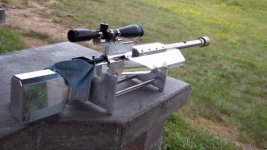Saved from awhile back on benchrest.com. Jackie's Tuner
The Tuner
________________________________________
I wanted to send more pictures, but I feel fortunate that I was able to get one through.
The tuner is made of aluminum. The brass is only 1/16 thick, has hard rubber vulcanized in the ID, and is pressed tightly over the aluminum tuner body. In fact, it is a 1 1/8 ID Marine Propellor Shaft Bearing. The most popular brand in our industry is the Johnson Duramax. These bearings do not go by part number, but by Code Name. The Code Name for the 1 1/8 x 1 5/8 x 5 1/4 inches long bearing is "Belt".
As you can see, you can get enough bearing length for two tuners. The brass shell can be turned to get the weight where you want it, more for an HV if you are so inclined.
You can turn the OD of the tuner to 1.155, and that will give the rubber bearing, (they are all a precision size), about .020 press over the tuner. Once it is on there,it will not move.
That bearing will cost about $40 The rubber is what I call the snubber. It is just an idea I came up with. Consider the assembly as all one piece.
I make this tuner. I have made a few for friends, that particular one is going to Russ Hardy. I have no intentions of making them "for money", I have plenty to do running my business. The overall length is 3 1/4 inches, and the entire thing weighs a touch over 6 ounces. I suppose you could install it on any Rifle that has a barrel at least .900 at the muzzle.
This particular one has a .900 diameter 36 tpi on the inside. The rest of the ID is about 7/8 diameter. The barrel has a corresponding thread, 2 inches in length, on the barrel. You do have to loosen the pinch bolts to move the tuner, or at least I do. All you have to do is lightly cinch the bolts, as the thread has a lot of area.
The integral locking collar, where the two Socket Head Capscrews are, is 1.5 inches in diameter. The split runs up about 1/4 inch further than what you can see.
Anybody with a lathe a small milling machine,and basic skills can build one of these.......jackie
View attachment 12293 This link works sometimes, sometimes not. Don't have any idea why, but the photo is the same as the first one in the photos a couple of replies down.





